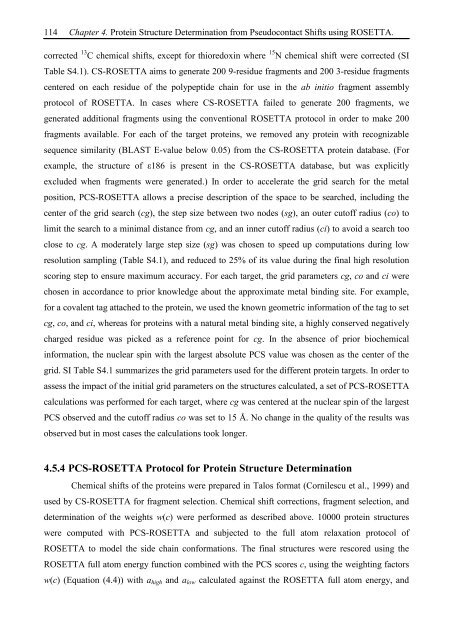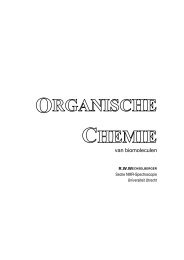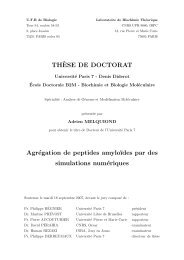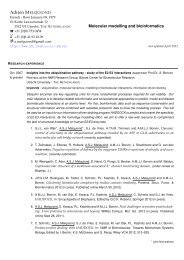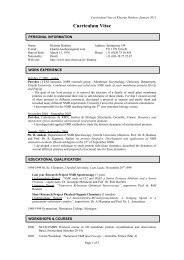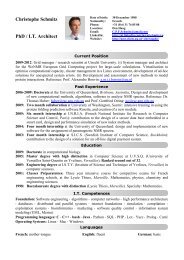Thesis Title: Subtitle - NMR Spectroscopy Research Group
Thesis Title: Subtitle - NMR Spectroscopy Research Group
Thesis Title: Subtitle - NMR Spectroscopy Research Group
Create successful ePaper yourself
Turn your PDF publications into a flip-book with our unique Google optimized e-Paper software.
114 Chapter 4. Protein Structure Determination from Pseudocontact Shifts using ROSETTA.<br />
corrected 13 C chemical shifts, except for thioredoxin where 15 N chemical shift were corrected (SI<br />
Table S4.1). CS-ROSETTA aims to generate 200 9-residue fragments and 200 3-residue fragments<br />
centered on each residue of the polypeptide chain for use in the ab initio fragment assembly<br />
protocol of ROSETTA. In cases where CS-ROSETTA failed to generate 200 fragments, we<br />
generated additional fragments using the conventional ROSETTA protocol in order to make 200<br />
fragments available. For each of the target proteins, we removed any protein with recognizable<br />
sequence similarity (BLAST E-value below 0.05) from the CS-ROSETTA protein database. (For<br />
example, the structure of ε186 is present in the CS-ROSETTA database, but was explicitly<br />
excluded when fragments were generated.) In order to accelerate the grid search for the metal<br />
position, PCS-ROSETTA allows a precise description of the space to be searched, including the<br />
center of the grid search (cg), the step size between two nodes (sg), an outer cutoff radius (co) to<br />
limit the search to a minimal distance from cg, and an inner cutoff radius (ci) to avoid a search too<br />
close to cg. A moderately large step size (sg) was chosen to speed up computations during low<br />
resolution sampling (Table S4.1), and reduced to 25% of its value during the final high resolution<br />
scoring step to ensure maximum accuracy. For each target, the grid parameters cg, co and ci were<br />
chosen in accordance to prior knowledge about the approximate metal binding site. For example,<br />
for a covalent tag attached to the protein, we used the known geometric information of the tag to set<br />
cg, co, and ci, whereas for proteins with a natural metal binding site, a highly conserved negatively<br />
charged residue was picked as a reference point for cg. In the absence of prior biochemical<br />
information, the nuclear spin with the largest absolute PCS value was chosen as the center of the<br />
grid. SI Table S4.1 summarizes the grid parameters used for the different protein targets. In order to<br />
assess the impact of the initial grid parameters on the structures calculated, a set of PCS-ROSETTA<br />
calculations was performed for each target, where cg was centered at the nuclear spin of the largest<br />
PCS observed and the cutoff radius co was set to 15 Å. No change in the quality of the results was<br />
observed but in most cases the calculations took longer.<br />
4.5.4 PCS-ROSETTA Protocol for Protein Structure Determination<br />
Chemical shifts of the proteins were prepared in Talos format (Cornilescu et al., 1999) and<br />
used by CS-ROSETTA for fragment selection. Chemical shift corrections, fragment selection, and<br />
determination of the weights w(c) were performed as described above. 10000 protein structures<br />
were computed with PCS-ROSETTA and subjected to the full atom relaxation protocol of<br />
ROSETTA to model the side chain conformations. The final structures were rescored using the<br />
ROSETTA full atom energy function combined with the PCS scores c, using the weighting factors<br />
w(c) (Equation (4.4)) with ahigh and alow calculated against the ROSETTA full atom energy, and


